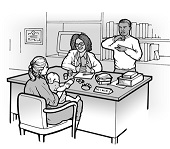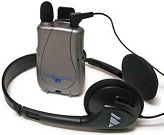Department of Managed Health Care
Communication Access - Hearing Disabilities Fact Sheet
If You Are Hard-of-Hearing, Deaf, or Have a Speech Disability
Make sure you understand your health care
What is communication access?
It means getting information in ways that you can understand and use. For example:
- You can get help talking to your doctors, such as a sign language interpreter or Assistive Listening Device.
- You can get an oral interpreter who repeats speech that is hard to understand.
- You can get more time to communicate with your doctor.
- You can get help to understand written information.
Who needs this access?
You might need it if you have limited hearing, reading, or speaking. You might also need it if you are helping someone get health care – such as your child, another family member, or a friend.
Why does this access matter?
It is very important to understand your health care. You need to understand your doctor’s advice. You need to ask questions and understand the answers. You may need a longer appointment.
What if I can’t get the help I need?
You can file a complaint with your health plan. The phone number is on your membership card. You may also learn more and File a Complaint online or call the Help Center at 1-888-466-2219. TTY 1-877-688-9891
Do I have a right to communication access?
Yes, if you have a disability. The federal Americans with Disabilities Act along with other California laws protect your rights.
Do I pay for access?
No. There is no cost to you.
Is it okay to depend on written notes?
Written notes may work for a short visit, like getting a flu shot. But often, an interpreter or other access is important, so you can ask questions and get answers.

Examples of communication access:
Sign language interpreter
The interpreter can be in the same room with you, or on a video screen.

Assistive listening device
This device can make voices clearer and easier to understand. It can often reduce background noise. You can use it with or without hearing aids. You listen with an earphone.

CART (computer assisted real time transcription services)
For CART, someone types words into a computer. You can read the words on the screen. The typist can be at the doctor’s office or can listen by phone. This may be helpful if you have hearing loss but you don’t use sign language.
Pictures, models and captioned videos
These tools can help you understand your care. Captions are words that appear at the bottom of the screen – you can read them if you have trouble hearing.

What access do I need?
Each person has different needs. Review the checklist below. Mark down what your access needs are and consider if there are any needs you might have that are not listed that you want to add. Then, ask your health plan, doctors, and pharmacy to keep a copy of this list of requested reasonable accommodations in your medical records. Before your appointment, you can also talk to the doctor’s office about the things you checked.
Access Checklist
Check what you need in the list below. Tell your health plan, doctors, and pharmacy about the access you need. Ask them to keep this information in your record.
- I need a sign language interpreter.
- I need an assistive listening device.
- I need CART (computer assisted real time transcription services).
- I need extra time for my appointments.
- I need to get appointment reminders in a text message.
- I need help understanding information.
Other needs:
- _______________________________
- _______________________________